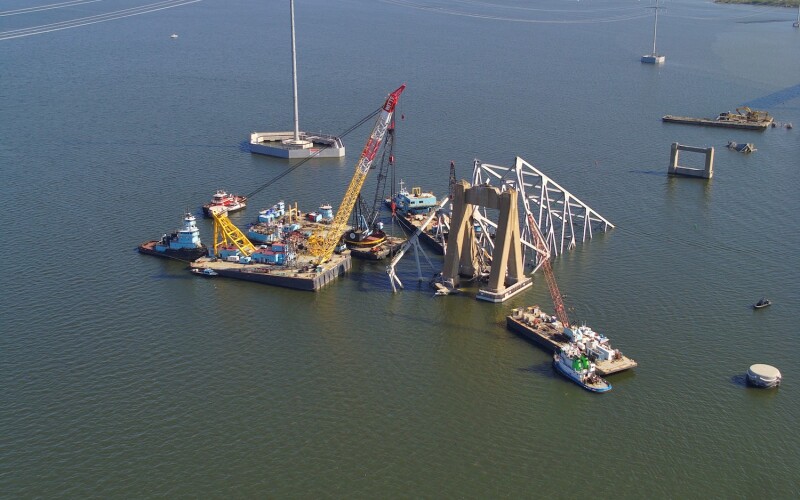Federal and Maryland officials say plans are on track for opening a 35’ depth limited access channel Thursday past the wreckage of the Francis Scott Key Bridge, potentially allowing departure of cargo vessels stranded at Baltimore since the March 26 bridge collapse.
The barge crane Chesapeake 1000 removed a 560-ton piece of structural steel Monday to help open the limited access channel, running along the northern portion of the wider 50’ Fort McHenry federal channel.
The 985’ containership Dali remains stranded alongside the bridge pier it struck after losing power during its outbound transit March 26. Salvors have worked incrementally around the ship removing wreckage to a makeshift recycling yard at the Tradepoint Atlantic terminal, allowing limited passage of shallow-draft tugs and barges through emergency channels.
“In achieving this important milestone, we continue to signal our resolute commitment to the people of Baltimore and the nation that we will not rest until the Port of Baltimore returns to normal operations,” said Lt. Gen. Scott Spellmon, the Army Corps of Engineers commander.
“Clearing this limited access channel would not have been possible without the integrated efforts of our amazing partners with the Navy’s Supervisor of Salvage and Diving, as well as the partnerships across our federal, state and local agencies.”
Next steps include sonar surveys by the Army corps, Coast Guard crews placing navigation aids, and producing of updated nautical charts by the National Oceanic and Atmospheric Administration, according to the Arm corps. “Port officials will then determine the viability of resuming commercial one-way maritime traffic in and out of the Port of Baltimore on a case-by-case basis.”
The 35’ channel will have a horizontal clearance of 300 feet, and vertical clearance of 214 feet. The Coast Guard Captain of the Port will permit transit within the limited access channel with restrictions, including weather limitations that may impact transit times.
“When deemed operational, the LAC is expected to provide passage for a limited number of commercial vessels into the Port of Baltimore and a departure opportunity for some deep draft vessels currently unable to leave the harbor since the bridge collapse,” according to the corps.
“The salvage work that's taking place is dangerous and very complex – all in an unforgiving environment,” said The Army corps’ Baltimore District commander Col. Estee Pinchasin. “From Navy’s Supervisor of Salvage and Diving to our partners with industry and in cooperation with the entire Unified Command, I am pleased with the ongoing tireless commitment to achieve this magnitude of progress without any significant safety incidents.”



.JPG.small.400x400.jpg)

